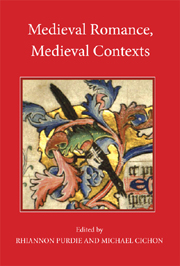Book contents
- Frontmatter
- Contents
- Acknowledgements
- Contributors
- Abbreviations
- Introduction: Romance and its Medieval Contexts
- 1 The Pleasure of Popular Romance: A Prefatory Essay
- 2 Representations of Peasant Speech: Some Literary and Social Contexts for The Taill of Rauf Coilyear
- 3 ‘As ye have brewd, so shal ye drink’: the Proverbial Context of Eger and Grime
- 4 Ekphrasis and Narrative in Emaré and Sir Eglamour of Artois
- 5 What's in a Name? Anglo-Norman Romances or Chansons de geste?
- 6 ‘For Goddes loue, sir, mercy!’: Recontextualising the Modern Critical Text of Floris and Blancheflor
- 7 Roland in England: Contextualising the Middle English Song of Roland
- 8 Romance Baptisms and Theological Contexts in The King of Tars and Sir Ferumbras
- 9 Modern and Medieval Views on Swooning: the Literary and Medical Contexts of Fainting in Romance
- 10 Walking (between) the Lines: Romance as Itinerary/Map
- 11 Romances of Continuity in the English Rous Roll
- 12 ‘Ex Libris domini duncani / Campbell de glenwrquhay/ miles’: The Buik of King Alexander the Conquerour in the household of Sir Duncan Campbell, seventh laird of Glenorchy
- 13 ‘Pur les francs homes amender’: Clerical Authors and the Thirteenth-Century Context of Historical Romance
- Index
- Volumes already published
5 - What's in a Name? Anglo-Norman Romances or Chansons de geste?
Published online by Cambridge University Press: 12 September 2012
- Frontmatter
- Contents
- Acknowledgements
- Contributors
- Abbreviations
- Introduction: Romance and its Medieval Contexts
- 1 The Pleasure of Popular Romance: A Prefatory Essay
- 2 Representations of Peasant Speech: Some Literary and Social Contexts for The Taill of Rauf Coilyear
- 3 ‘As ye have brewd, so shal ye drink’: the Proverbial Context of Eger and Grime
- 4 Ekphrasis and Narrative in Emaré and Sir Eglamour of Artois
- 5 What's in a Name? Anglo-Norman Romances or Chansons de geste?
- 6 ‘For Goddes loue, sir, mercy!’: Recontextualising the Modern Critical Text of Floris and Blancheflor
- 7 Roland in England: Contextualising the Middle English Song of Roland
- 8 Romance Baptisms and Theological Contexts in The King of Tars and Sir Ferumbras
- 9 Modern and Medieval Views on Swooning: the Literary and Medical Contexts of Fainting in Romance
- 10 Walking (between) the Lines: Romance as Itinerary/Map
- 11 Romances of Continuity in the English Rous Roll
- 12 ‘Ex Libris domini duncani / Campbell de glenwrquhay/ miles’: The Buik of King Alexander the Conquerour in the household of Sir Duncan Campbell, seventh laird of Glenorchy
- 13 ‘Pur les francs homes amender’: Clerical Authors and the Thirteenth-Century Context of Historical Romance
- Index
- Volumes already published
Summary
Whilst many Middle English romances were derived from Anglo-Norman texts in the form of chanson de geste, there is a long established view that there was no such thing as an Anglo-Norman chanson de geste. The Anglo-Norman versions of Horn and Boeve de Haumtone, both described by Dominica Legge as ‘romances in chanson de geste form’, are usually discussed with the other so-called ‘ancestral’ romances such as Gui de Warewic, Waldef, Havelok and Fouke Fitz Warin. Anglo-Norman redactions of continental chansons de geste have been labelled ‘chansons de geste’ but these are generally seen as ‘mere adaptations’ and given little attention as independent texts even when (as in the case of the Anglo-Norman Fierenbras) the reworking has been considerable.
This discrepancy raises questions regarding the definition of medieval genres. Are our genre labels simply modern critical constructs imposed on medieval texts? Critics have been asking this for nearly half a century. Does it matter if we ascribe different generic labels to these texts? The basic premise behind genre classification is the same as that behind other intertextual analysis: a clarification of what Northrop Frye called ‘traditions and affinities’. The perceived traditions and affinities will determine the horizon of expectations of the audience and an analysis of how the poets manipulate these expectations will bring us to a different appreciation of the texts.
- Type
- Chapter
- Information
- Medieval Romance, Medieval Contexts , pp. 61 - 76Publisher: Boydell & BrewerPrint publication year: 2011

